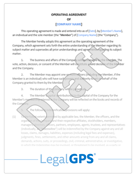The Ultimate Guide to Subordination Agreements
In the complex and dynamic world of business, financial contracts such as subordination agreements often lie at the heart of smooth operations and...
6 min read
LegalGPS : Oct. 7, 2024
As a business owner, you want to feel secure in your operations and protected from unexpected challenges or hazards. One vital tool that helps manage risk effectively in any business arrangement is the indemnity agreement. This article is an in-depth guide designed to equip you with all things indemnity, right from understanding the concept to its implementation in your business world.


Protect Your Business with Indemnity!
Legal GPS templates are drafted by top startup attorneys and are fully customizable🛠️.
Trusted by 1000+ businesses to close secure deals.
Often found nestled within contracts, an indemnity agreement, also known as a hold harmless agreement, is essentially a legal promise where one party agrees to cover the losses or damages experienced by another party in certain stated circumstances. In simple terms, it's an agreement that helps you shield your business from any financial loss that might occur due to the actions of another person involved in the transaction.
To add a touch of tangibility to the concept, let's look at a few examples:
Construction and rental agreements: Imagine you've hired a contractor to refurbish your office. In most cases, the contract will include an indemnity clause. This clause will protect you, the employer, from financial loss if there's any accidental property damage, or if any of the contractor's employees gets injured while working on your property.
Insurance contracts: Insurance contracts operate on the principle of indemnity. When you take auto insurance, for example, the insurance company agrees to cover the costs associated with any harm or damage your vehicle may cause.
Commercial insurance: Businesses often purchase commercial insurance policies that protect them from financial loss. For example, if you're operating a restaurant and someone slips on your greasy flooring and breaks their leg while eating there, then they could sue you for damages.
Writing an indemnity agreement might sound like a Herculean job reserved for lawyers, but with a few tips and guidance, you can draft a basic one by yourself. Here's your step-by-step guide:
Start with the basics. Who's involved in this agreement? A typical indemnity agreement involves two main parties:
The Indemnitor - this is the party who is agreeing to cover losses or damages.
The Indemnitee - this is the party who would be indemnified or protected against any potential loss or damage.
In the agreement, you'll need to state the full legal names (individual or company) of both parties, their legal addresses, and specify their roles as either the Indemnitor or the Indemnitee.
Next, you'll want to describe the agreement's purpose. This includes specifying the situations or activities that the indemnity agreement will cover. This section serves as a boundary that outlines the specific instances in which the indemnifier will be responsible for covering costs or damages.
For example, you might describe the indemnity agreement as applying to all activities that occur during the rental period. You can also specify what types of costs or damages are covered by this agreement, such as property damage or bodily injury.
Now, let's get into the finer details. How broad or narrow is this indemnity? It's crucial to detail the exact forms of damage or loss covered. This could include legal liabilities, losses, damages, costs, or claims that the Indemnitee might incur due to the agreed-upon circumstances.
For example, you may be agreeing to cover legal fees and other costs related to a breach of contract. Or, perhaps you're willing to cover any damages resulting from a breach of warranty or misrepresentation.
This section is where you'll outline the obligations of the Indemnitor. How exactly will they have to compensate the Indemnitee in case of any loss or damage? Will they be paying a set amount or reimbursing actual costs? How and when should this compensation be paid?
This might look something like: “The Indemnitor agrees to pay all legal fees, court costs and other expenses incurred by the Indemnitee in defending any claims made against them by any third party as a result of a breach of this contract.”
Most indemnity agreements also have exceptions. These are the rules that note when the indemnity clause does not apply. For instance, if the Indemnitee is found to be negligent or responsible for the damage, or if certain losses are outside the scope of the agreement.
For example, it might look like: “The Indemnitor agrees to pay all legal fees, court costs and other expenses incurred by the Indemnitee in defending any claims made against them by any third party as a result of a breach of this contract. This indemnity does not apply if the Indemnitee is found to have been negligent or responsible for the damage caused.”
Understanding Indemnity Agreements
Determine and include the timeline for your indemnity agreement to come into effect and how long it is intended to last. Will it remain in force indefinitely, renew annually, or end on a specific date? This helps clearly set the active duration of the indemnity clause.
It might look like: “The indemnity agreement will be in effect from [date] until [date]. If either party wishes to terminate this contract, they must give the other party 30 days written notice before doing so. This indemnity will automatically renew each year on the same date unless otherwise agreed to by both parties.”
It's also imperative to plan for potential disputes. Clearly mention how disputes related to the indemnity agreement will be resolved. Would you prefer arbitration, mediation, or court litigation? This can provide a roadmap for settling any potential disagreements peacefully and legally. This is important because if you don't specify a dispute resolution plan, the judge will decide for you.
Finally, seal the deal with the signatures of all parties involved, which will indicate that everyone understands the terms and is in agreement. Be sure to also include the date of signing.


Legal GPS Pro
Protect your business with our complete legal subscription service, designed by top startup attorneys.
Given its ability to shield your business from potential financial losses and legal hassles, it's easy to understand why investing time and effort to draw up an effective indemnity agreement is a wise decision. Here are a few reasons why:
Risk management: It helps manage your business's risk by transferring potential financial burdens to those best equipped to handle them. This means you can focus more on what you do best: running your business.
Safeguard reputation: Imagine facing a lawsuit due to a mishap from a subcontractor or any third-party related to your business. An indemnity agreement can protect your business's reputation by ensuring you're not held financially responsible.
Financial stability: Unforeseen incidents in business can impose heavy costs. Having an indemnity agreement shields the company from such unexpected financial bolt from the blue.
While drafting an indemnity agreement, it's easy to fall into a few common pitfalls which may render all your hard work futile. Some common mistakes include:
Being vague and unclear: Clarity is crucial when defining the circumstances where the agreement comes into effect, the parties involved, and any exceptions. Any ambiguity can lead to misunderstandings and legal disputes.
Not consulting a lawyer: Legal counsel becomes indispensable when it comes to understanding and navigating the complex legal language of these contracts. Having a lawyer involved from the start can save you headache and time in the long run.
Get Your Indemnity Agreement Template
with a Legal GPS Subscription
Now that we’ve tackled the composition of the agreement, let’s talk enforcement.
In the unfortunate event of liability or loss, the indemnity agreement is your shield. However, just like any legal document, it only works if it's enforceable. This means the agreement must be legally binding under the laws of your area and the conditions must be satisfied.
The legalities can sometimes feel like a maze, so let's break it down:
Lawful Purpose: An agreement, including an indemnity agreement, may be deemed unenforceable if the purpose of the agreement is found to contradict the laws. Always ensure that the agreement serves a lawful purpose.
Genuine Consent: Both parties must willingly enter the agreement, without coercion, duress, or misrepresentation.
Consideration: This is a legal term referring to the exchange of value. The indemnitor should reasonably expect something in return for taking on potential obligations.
Specific State laws: Some states may have specific stipulations around indemnity agreements, especially concerning construction contracts. Always be mindful of the laws in your region.
While it's true that an indemnity agreement is an essential tool for risk management, it's not a magic wand. It does have some limitations:
Enforcement difficulties: If the indemnitor refuses to honor the agreement or simply can't afford to cover the losses, recovering costs can become quite a challenge.
Constraints of the law: As mentioned above, there are cases where the law may not allow enforcement of indemnity agreements.

Protect Your Business with Indemnity!
Legal GPS templates are drafted by top startup attorneys and are fully customizable🛠️.
Trusted by 1000+ businesses to close secure deals.
To ensure that your indemnity agreement serves its purpose without any hiccups, here’s a checklist of key takeaways:
Make sure your agreement is detailed and clear. Any ambiguity can give rise to disputes.
Include a provision for updates or amendments to keep the agreement relevant over time.
Always consult legal counsel before implementing the agreement, and consider it for any significant amendments.
Ensure each party to the agreement has a signed copy as proof of consent.
Running a business is adventurous, but it doesn’t mean navigating risky waters without a life jacket. An indemnity agreement is the life jacket in the unpredictable seas of the business world. Protect your investment, manage risks smarter, and strategize for success.
Take the first step with our easy-to-use indemnity agreement template. Tailored by experts, it's designed to guide you through the crafting process, ensuring you cover all critical aspects.
Equip your business with this effective legal tool today. Harness the power of legal knowledge. Your epic entrepreneurial journey deserves no less!
The biggest question now is, "Do I need a business lawyer?” For most businesses and in most cases, you don't need a lawyer to start your business. Instead, many business owners rely on Legal GPS Pro to help with legal issues.
Legal GPS Pro is your All-In-One Legal Toolkit for Businesses. Developed by top startup attorneys, Pro gives you access to 100+ expertly crafted templates including operating agreements, NDAs, and service agreements, and an interactive platform. All designed to protect your company and set it up for lasting success.
Get Legal GPS's Indemnity Agreement Template Now

Legal GPS Pro
Protect your business with our complete legal subscription service, designed by top startup attorneys.
| Premium Template Single-use Template |
Legal GPS Pro Unlimited Access, Best Value |
|
|
| Get Template | Learn More |
| Trusted by 1000+ businesses | |
Table of Contents

In the complex and dynamic world of business, financial contracts such as subordination agreements often lie at the heart of smooth operations and...

Navigating the financial ecosystem as a growing business can be challenging. However, with the right contracts on hand, like Junior Lender Friendly...

When it comes to running a business, it's essential to cover all your bases to ensure the smooth operation of your company and the protection of your...